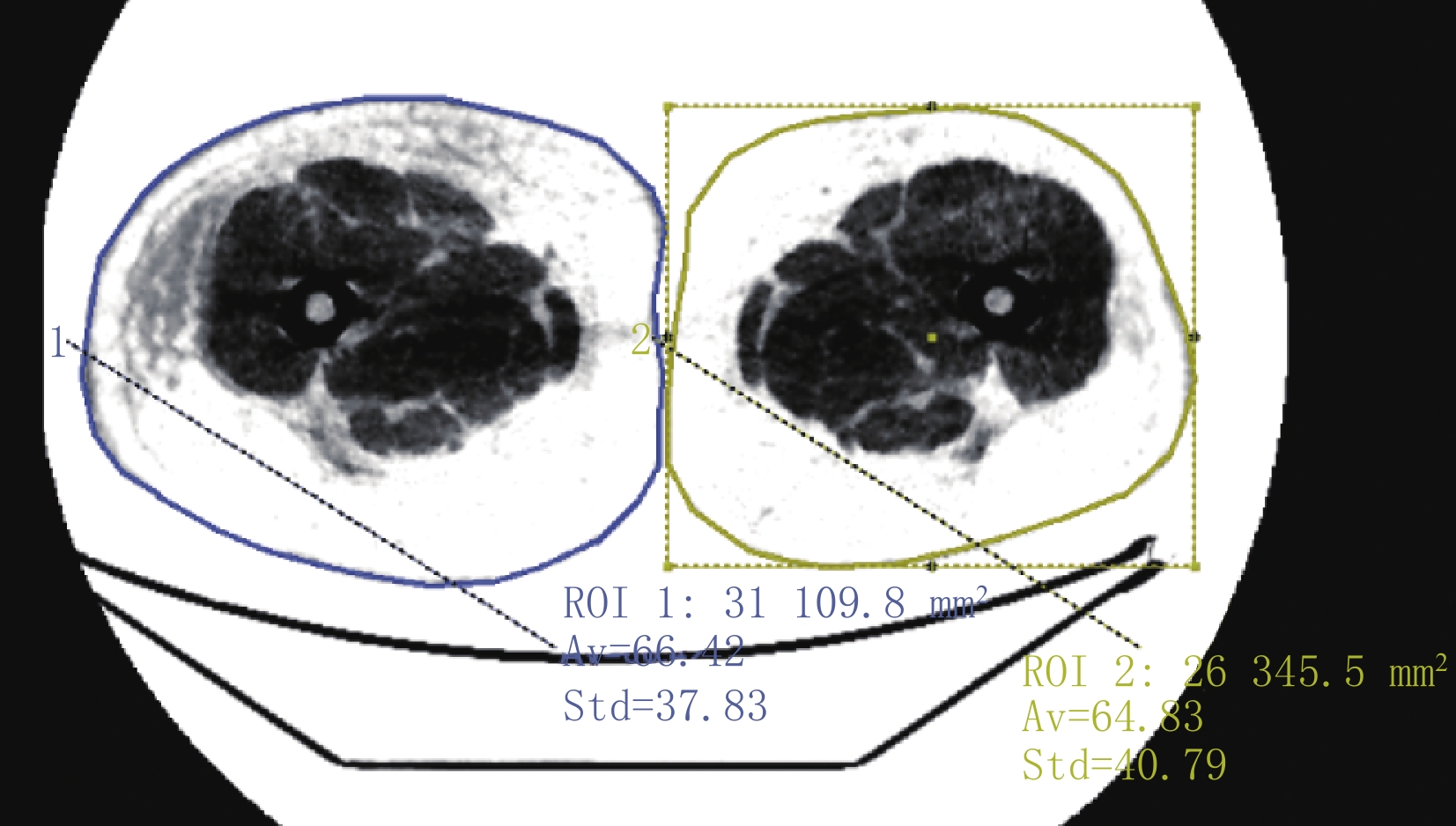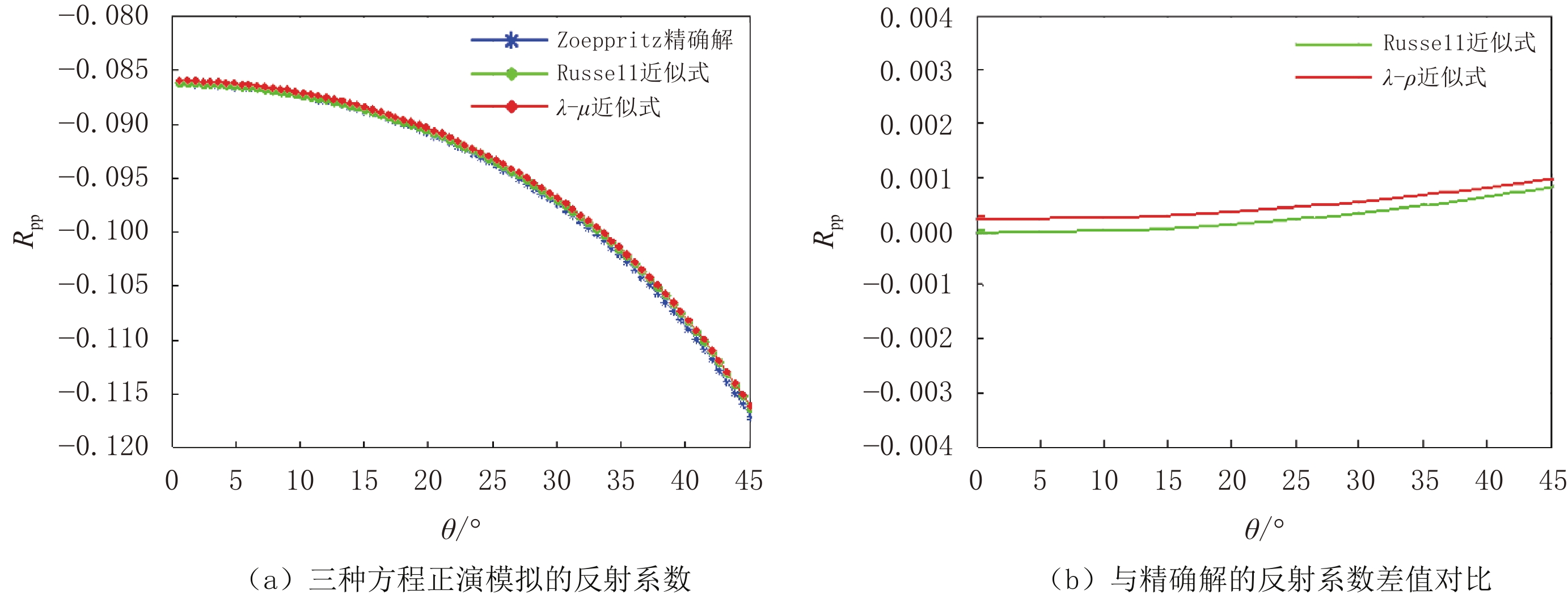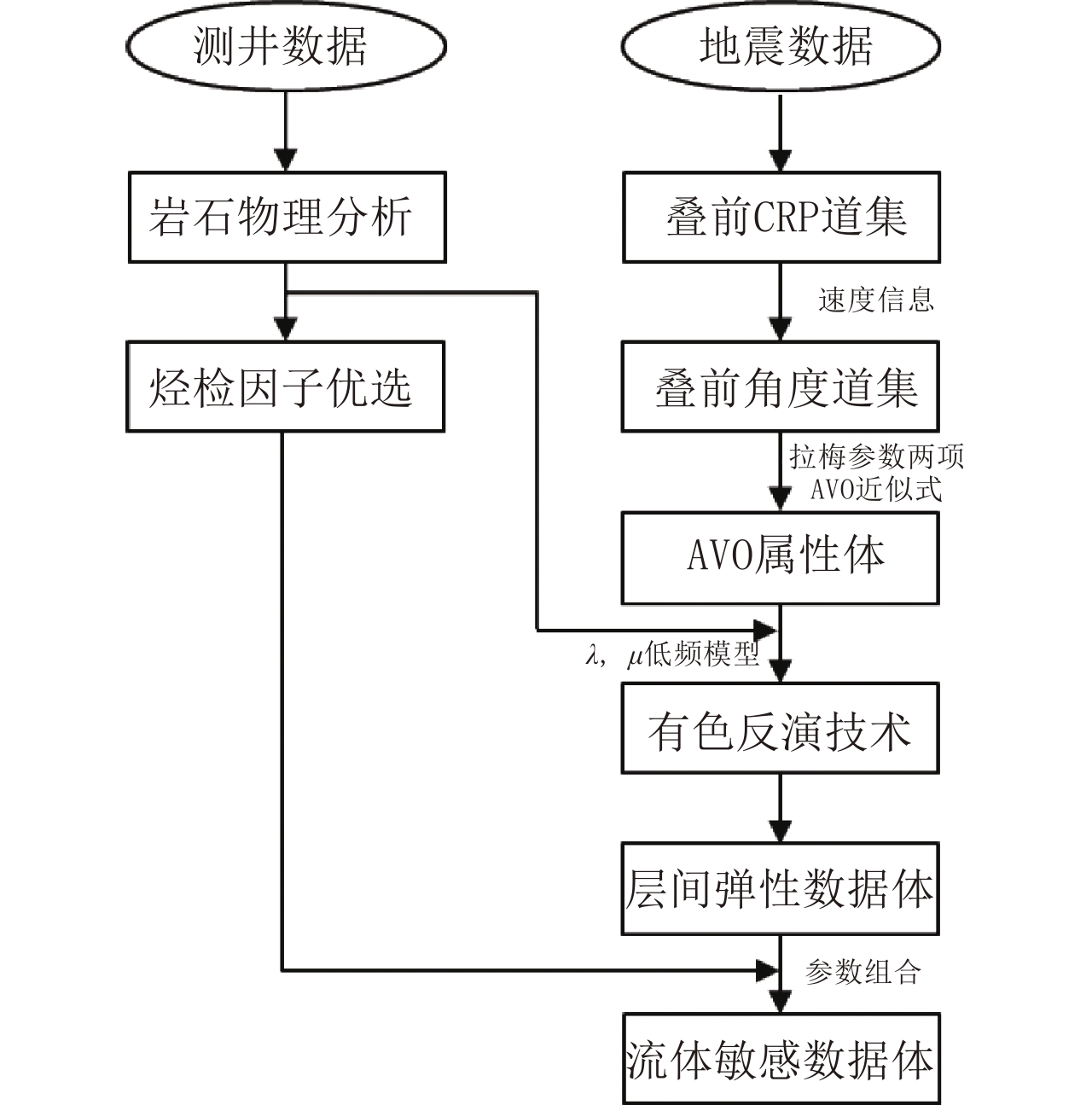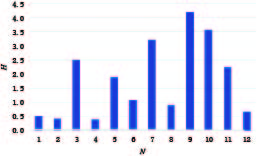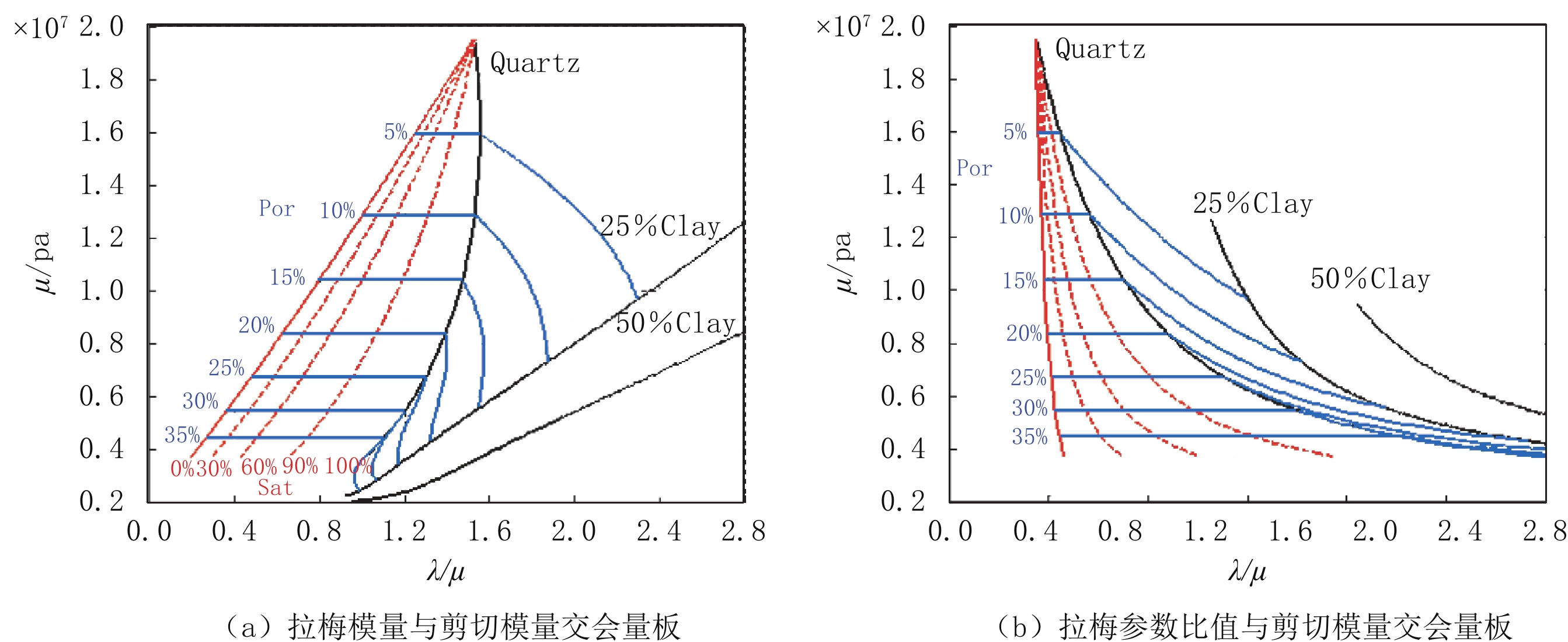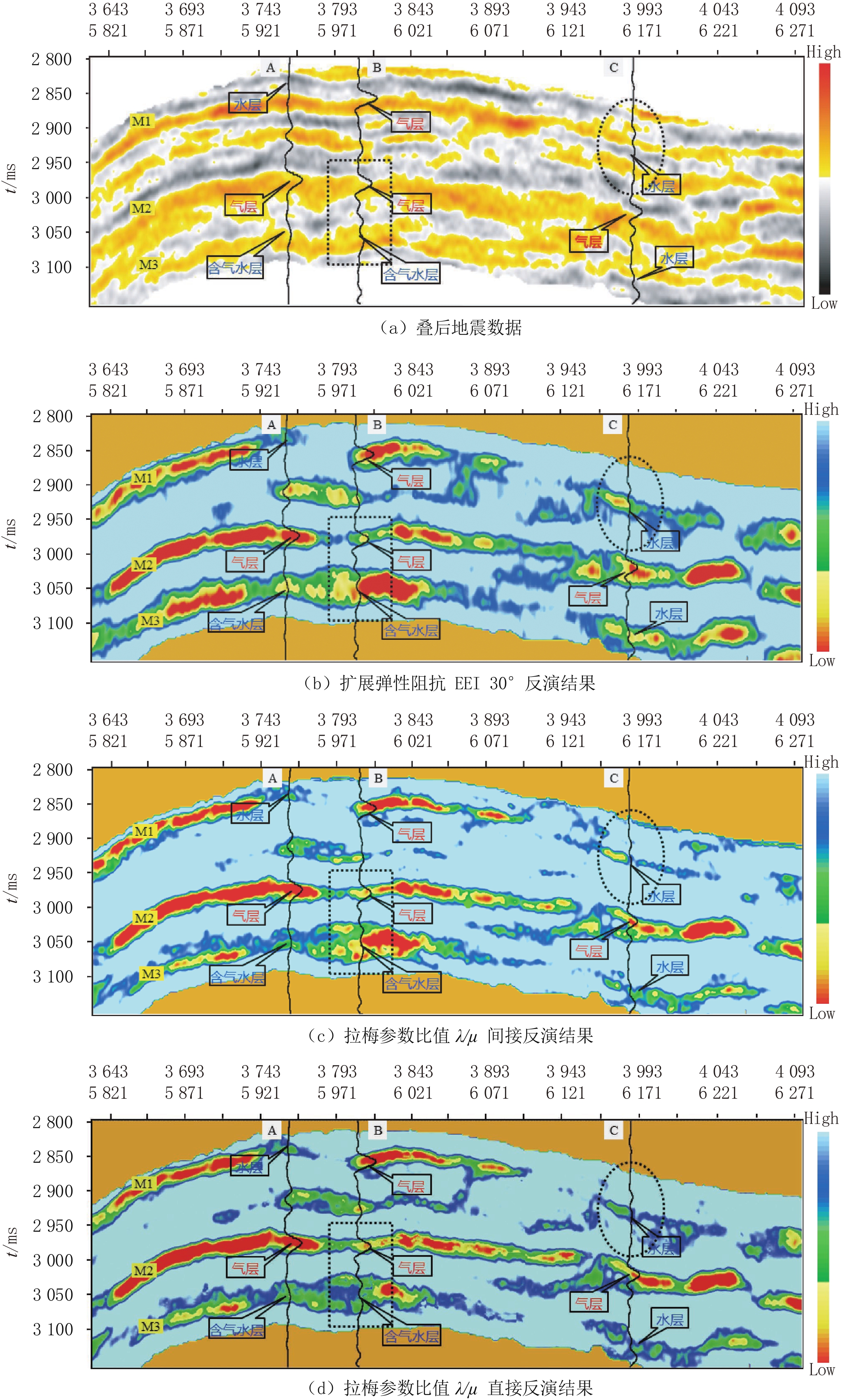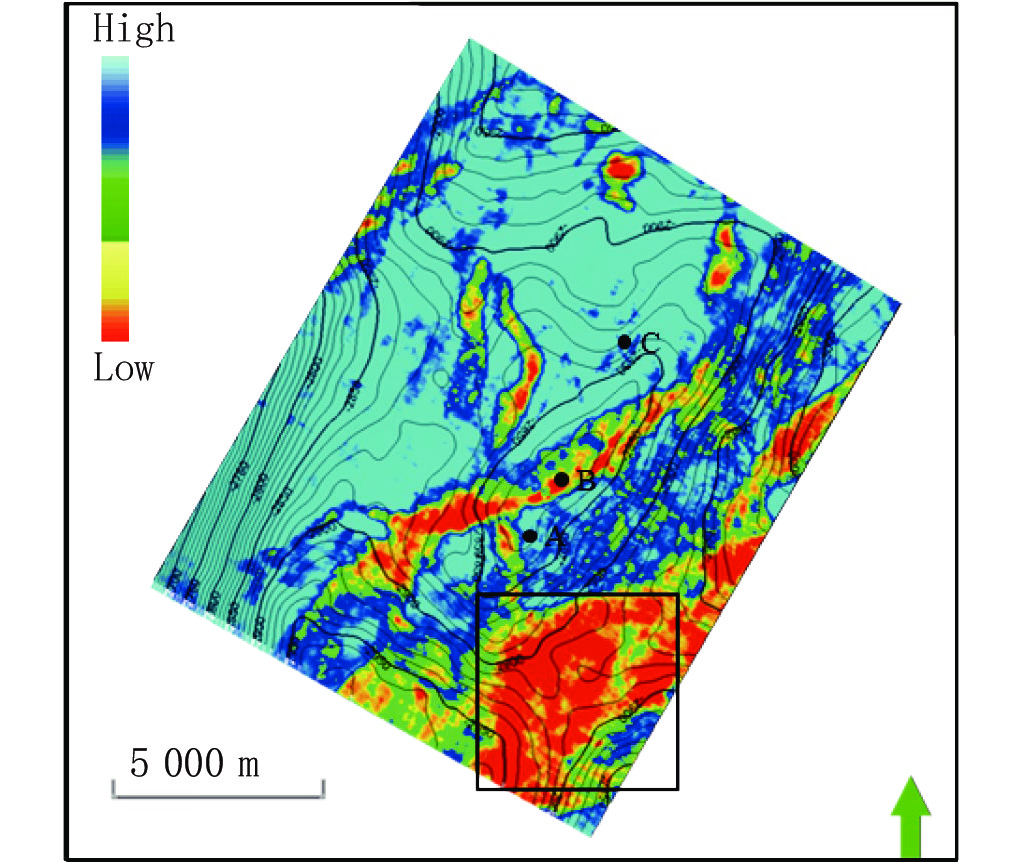Application of Lame Parameter Direct Inversion in Hydrocarbon Detection of Low-porosity and Low-permeability Reservoirs in N Structure in East China Sea Basin
-
摘要: 东海N构造主要目的层为强水动力环境下发育的三角洲平原分流河道砂体。平面砂层分布不连续,横向非均质性强。受埋深压实和成岩作用等影响,储层呈低孔渗特征,岩石物理规律叠置严重。此外,深部地震数据存在缺乏大角度入射信息等问题,落实研究区致密储层流体分布范围对于勘探开发设计部署具有重要意义。本文引入一种基于拉梅参数直接反演的地震流体描述方法,通过实测井数据的岩石物理定性和定量判析,优选流体敏感参数,进而结合拉梅参数的两项AVO模型参数化方程,从叠前道集中分别提取拉梅参数的AVO属性体。然后利用有色反演技术直接提取流体敏感弹性信息,以指导地震流体描述。实例应用表明,该方法的烃检结果与测井解释成果匹配度高,能够有效刻画研究区致密储层流体展布规律,可为新领域油气资源发现提供重要技术支撑。Abstract: The main target layer of the N structure in the East China Sea is a delta subaqueous distributary channel sand body developed under a strong hydrodynamic environment. The distribution of planar sand layer is discontinuous and the lateral heterogeneity is very strong. Under the influence of deep burial compaction and diagenesis, the reservoir is characterized by low porosity and low permeability, and the properties of rock-physics are overlapped seriously. In addition, the lack of large angle information of deep seismic data is a common problem. It is of great importance to implement the fluid distribution range of tight reservoir in the study area for the design and deployment of exploration and development. In this paper, a new method of deep seismic fluid description is introduced based on direct inversion of lame parameters. Through qualitative and quantitative analysis of rock-physics of measured well data, optimal highly sensitive hydrocarbon detection factor is selected. Furthermore, the AVO properties of Lambda parameters are extracted from the pre-stack trace set by combining with the parametric equations of the two AVO models of Lambda parameters. Then, the AVO properties are directly transformed into the interlayer elastic information by using the colored inversion technique. Finally, the seismic fluid sensitive elastic data is obtained to guide the seismic fluid description. The practical application shows that the hydrocarbon detection results of this method are compatible with the logging interpretation achievement, and can effectively describe the low-porosity and low-permeability reservoirs fluid development law of the study area, and can provide important technical support for the discovery of oil and gas resources in new fields.
-
Keywords:
- colored inversion /
- rock-physics /
- AVO approximation equation
-
继发性下肢淋巴水肿作为一种慢性致残性疾病,多由腹盆腔恶性肿瘤切除和/或放射治疗损伤淋巴系统所致,患者常伴有下肢肿胀、疼痛、活动受限等症状,继发于妇科恶性肿瘤术后的下肢淋巴水肿发生率可高达60%[1-2],严重影响癌症幸存者心理健康与生活质量,但是目前临床上并没有理想的治疗方式适用于所有继发性下肢淋巴水肿的患者[3],因此明确下肢淋巴水肿诊断与分级对癌症幸存者意义深远。
仅依据2016版国际淋巴学会共识[4]中患肢体积较健肢体积增大的百分比将患者分为轻、中、重3级,不足以明确疾病进展程度,这主要是因为继发性淋巴水肿患者肢体体积增大的成分多样,包括脂肪及纤维化等[5],即使体积增大比例一致,以脂肪为主型和纤维化为主型的不同患者手术的难度和风险也大相径庭[6]。此外,处于不同分级的患者组织增加的成分也可能相同。
能谱CT不仅可通过阈值测量法量化体积,还可利用不同物质在不同X线能量下的吸收情况提供比常规CT更多的信息[7],本研究通过能谱CT多物质解析算法量化淋巴水肿肢体脂肪含量比,以期为临床提供更多的分级诊断信息。
1. 材料与方法
1.1 一般资料
本研究通过医院伦理委员会批准,搜集2019年6月至2020年6月因继发性下肢淋巴水肿入我院就诊的40例患者。
入组标准:①恶性肿瘤根治性切除术后和/或放射治疗后出现单侧下肢淋巴水肿的患者;②于下肢淋巴水肿治疗前行能谱CT检查的患者;③签署知情同意书的患者。排除标准:①原发性下肢淋巴水肿患者以及其它任何原因如心源性、血管源性、肝肾功能不全、代谢性疾病等导致的下肢水肿患者;②合并恶性肿瘤复发和/或淋巴结转移的患者。
1.2 能谱CT成像与后处理
所有检查均在GE Revolution CT完成,扫描范围自盆腔至双足,患者双腿保持解剖学定位,双脚稍微分开。扫描参数:管电压80/140 kVp快速切换,管电流自动调节模式100~200 mA,噪声指数12,Asir比例40%,球管旋转时间0.5 s,螺距0.992∶1,探测器宽度8 cm,矩阵512×512,SFOV 50 cm。
所得原始数据均以2.5 mm层厚,2.5 mm层间隔进行三维重组,所得能谱CT图像均导入GE AW 4.7工作站,使用水-脂肪作为基物质对进行后处理,将原始图像处理为水基和脂肪基物质图,将所得脂肪基物质图分别重组为轴面、冠状面、矢状面图像。
采用CT阈值法分别测量患侧与健侧下肢体积(图 1)。基于多物质解析的脂肪量化算法显示2.5 mm层厚的脂肪体积分数图像(图 2),对下肢脂肪含量进行定量评估,分别选取患侧及健侧全下肢作为感兴趣区域,记录患侧及健侧全下肢脂肪体积分数值。为了确保观察者间和观察者内的一致性,所有能谱CT图像均由两名5年以上工作经验的放射科医生共同测量。
![]() 图 1 能谱CT平扫下肢轴面图像,分别选取患侧与健侧同层面为感兴趣区,该截面患侧和健侧肢体脂肪体积(cm3)分别为26.1±152.4和22.0±169.1Figure 1. The axial image of lower extremity by spectral CT plain scan. The same section of the affected and healthy side were selected as the ROIs, the fat volume of the affected and healthy side on this section (cm3) is 26.1±152.4 and 22.0±169.1, respectively
图 1 能谱CT平扫下肢轴面图像,分别选取患侧与健侧同层面为感兴趣区,该截面患侧和健侧肢体脂肪体积(cm3)分别为26.1±152.4和22.0±169.1Figure 1. The axial image of lower extremity by spectral CT plain scan. The same section of the affected and healthy side were selected as the ROIs, the fat volume of the affected and healthy side on this section (cm3) is 26.1±152.4 and 22.0±169.1, respectively![]() 图 2 下肢轴面脂肪体积分数CT图像,分别选取患侧与健侧同层面为感兴趣区,该截面患侧和健侧肢体脂肪体积分数(%)分别为:66.42±37.83和64.83±40.79Figure 2. The axial FVF image of the lower extremity. The same section of the affected and healthy side were selected as the ROIs, the percentage FVF of the affected and healthy side on this section is 66.42±37.83 and 64.83±40.79, respectively
图 2 下肢轴面脂肪体积分数CT图像,分别选取患侧与健侧同层面为感兴趣区,该截面患侧和健侧肢体脂肪体积分数(%)分别为:66.42±37.83和64.83±40.79Figure 2. The axial FVF image of the lower extremity. The same section of the affected and healthy side were selected as the ROIs, the percentage FVF of the affected and healthy side on this section is 66.42±37.83 and 64.83±40.79, respectively1.3 统计学分析
所有数据均采用SPSS 25.0版软件进行统计分析,分别计算CT阈值测量法所得患侧与健侧下肢体积的中位数及标准差。计算(患侧下肢体积 - 健侧下肢体积)/健侧下肢体积的结果,参照2016版国际淋巴协会共识分级标准,将入组患者分为轻、中、重度3级。
采用配对 t 检验分别分析轻、中、重度患者患侧与健侧下肢脂肪体积分数之间的差异。采用秩和检验分析轻、中、重度患者之间患侧下肢脂肪体积分数的差异。P<0.05认为差异有统计学意义。
2. 结果
2.1 患者一般资料
最终入组患者40例,女/男(36/4),年龄范围32~71岁,中位年龄(53±10)岁,病程(3±5)年,主要临床表现为单侧下肢肿胀(左侧24例,右侧16例)、疼痛、活动受限。其中继发于子宫内膜癌7例,宫颈癌22例,卵巢癌4例,腹股沟肿瘤4例,阴茎癌1例,下肢皮肤病变2例。轻度8例,中度14例,重度18例。
2.2 测量结果及统计学分析
CT阈值法测得全组、轻度、中度以及重度患者的患侧与健侧下肢体积值见表1,全组、轻度、中度以及重度患者患侧与健侧下肢体积差异均有统计学意义。
表 1 能谱CT阈值法测量患侧与健侧下肢体积Table 1. The volume of the affected and healthy side by spectral CT threshold value software分级\部位 体积/cm3 统计检验 患侧 健侧 t P 全组(n=40) 9962±2261 6762±1422 11.302 0.000 轻度(n=8) 8358±2213 7379±1862 8.126 0.000 中度(n=14) 8705±1701 6547±1314 15.460 0.000 重度(n=18) 10684±1864 6927±1376 15.487 0.000 能谱CT多物质解析算法测得全组、轻度、中度以及重度患者患侧与健侧下肢脂肪体积分数见表2,全组、轻度、中度以及重度患者的患侧下肢脂肪体积分数与健侧差异均有统计学意义。
表 2 能谱CT多物质解析算法测量患侧与健侧下肢脂肪体积分数Table 2. The percentage FVF of the affected and healthy side by spectral CT MMD algorithm分级\部位 脂肪体积分数/% 统计检验 患侧 健侧 t P 全组(n=40) 58.00±6.98 54.96±8.71 5.195 0.000 轻度(n=8) 57.98±5.96 55.37±7.53 2.430 0.045 中度(n=14) 58.20±9.08 54.36±10.19 3.987 0.002 重度(n=18) 57.86±5.84 55.25±8.42 2.693 0.015 能谱CT阈值测量法显示入组患者的患侧下肢体积均大于健侧下肢体积,这一差异在轻、中、重度组均存在,下肢体积增大百分比最大的患者患侧和健侧下肢体积分别为10071 cm3和4764 cm3,体积增大百分比高达 111%。
能谱CT多物质解析算法显示入组患者的患侧脂肪体积分数均大于健侧脂肪体积分数,这一差异同时存在于轻、中、重度组患者中,体积增大百分比最大的患者患侧和健侧脂肪体积分数分别为48.46% 和 45.04%。
轻、中、重度3组患者两两之间患侧下肢脂肪体积分数的差异均无统计学意义,提示脂肪体积分数这一单一参数不能用于区分轻、中、重度下肢淋巴水肿。
3. 讨论
继发性下肢淋巴水肿是由外伤、感染、放疗和/或手术等引起淋巴回流机械阻塞,患侧下肢淋巴液积聚、脂肪及纤维化等多种成分的增加导致患侧肢体进行性肿胀[8],不同疾病进程的治疗方式不同,淋巴静脉吻合术对继发性下肢淋巴水肿轻度患者更有效,中度和重度患者需联合下肢脂肪抽吸手术[9]。目前临床上主要依据2016版国际淋巴学会共识中体积增大百分比对继发性下肢淋巴水肿患者进行分级诊断,常采用软尺测量下肢多径线,将所得数据代入圆锥体公式计算下肢体积,但是该方法受测量者主观因素影响较大,且是估值数据[10]。
CT阈值法已广泛应用于乳突气房、颅内血肿、肌肉、脏器脂肪等的测量中[11-13],本研究的前期研究已证实CT阈值法与临床多径线测量法对继发性下肢淋巴水肿肢体体积测量的一致性非常好[14]。
研究[15]证明肥胖是发生淋巴水肿的危险因素,并且该风险与体重成正比,与此同时淋巴水肿也可引起功能失调的脂肪细胞肥大和增生,从而导致继发性局部脂肪沉积,这两个过程通过正反馈不断维持和加强。下肢脂肪抽吸术[1,6]可去除过多的皮下脂肪组织,适用于淋巴管功能丧失的患者,可有效缓解患肢肿胀,改善肢体塑性,但是不同脂肪含量患者的手术难度不同。目前临床上急需有效的脂肪体积量化工具,帮助临床医生进行术前预警及术后疗效评价。
文献[7, 16-18]报道中主要的脂肪体积测量方法有:质子磁共振波谱和能谱CT多物质解析算法等,其中质子磁共振波谱是基于组织中脂肪和水的质子密度比来测得脂肪含量的,不是体积测量,应用于脂肪肝患者时还存在脂肪含量高估的情况[7],且磁共振扫描时间长、价格昂贵等也加重了患者负担。相较之下,CT扫描时间短,更具价格优势,快速管电压切换的能谱CT可以生成多个参数并提供定性和定量分析,尤其是能谱CT多物质解析算法,可以区分 3 种甚至更多种不同的物质,生成脂肪体积分数图像对脂肪含量进行定量和可视化评估,尤其适用于成分复杂的人体器官,如血液、脂肪、水和骨骼等,既往的研究证实能谱CT的肝脏脂肪体积分数值准确且可重复[7,17],能谱CT多物质解析技术还可有效识别骨骼、肺和软组织[18],但是目前尚没有应用于淋巴水肿类疾病的报道。
本研究首次将能谱CT多物质解析算法应用于继发性下肢淋巴水肿患者下肢脂肪含量的测量中,与健侧相比,轻、中、重度患者患侧下肢的脂肪体积分数均大于健侧。这符合继发性下肢淋巴水肿患者皮下脂肪沉积的病理生理特征[5,8]。但是轻、中、重度患者两两之间患侧下肢脂肪体积分数的差异无统计学意义,这主要是由于脂肪体积分数是感兴趣区范围内下肢的脂肪占据全下肢的比例,不是绝对量,要受到患侧下肢本体基线体积、增生程度和纤维化程度等多种因素影响[8]。因此,只依据单一参数不具备完全量化分析能力,需结合上述多因素,才能进行准确评价。
本研究的不足:①除了脂肪含量外,纤维化的程度对于评估继发性下肢淋巴水肿严重程度也很重要,下一步的研究需进一步加入纤维化含量的分析;②本研究样本量较小,下一步需要增大样本量,进一步探讨处于同一分级患者的脂肪体积分数是否存在差异;③本次研究中我们没有进行治疗前后脂肪体积分数变化的对比,下一步的研究可将治疗前后进行对照分析,进行疗效评价;④CT扫描具有辐射,但是本研究主要针对恶性肿瘤患者,且辐射剂量远低于多时相腹盆腔CT扫描。
4. 结论
能谱CT多物质解析算法可以量化继发性下肢淋巴水肿的脂肪含量比,但不能单独用于继发性下肢淋巴水肿的分级评价中。
-
表 1 含气砂岩和含水砂岩模型弹性参数
Table 1 Parameters of the sandstone model
地层 Kdry/GPa μ/GPa $\gamma ^2_{{\rm{dry}}}$ $\gamma ^2_{{\rm{sat}}} $ $\rho $/(g/c3) VP/(m/s) VS/(m/s) 含水砂(上层) 3 3 2.32 4.48 1.9 2680 1265 含气砂(下层) 3 3 2.30 3.51 1.7 2520 1345 -
[1] 张世鑫. 基于地震信息的流体识别方法研究与应用[D]. 青岛: 中国石油大学(华东), 2012. ZHANG S X. Methodology and application of fluid identification with seismic information[D]. Qingdao: China University of Petroleum (East China), 2012. (in Chinese).
[2] 印兴耀, 宗兆云, 吴国忱. 岩石物理驱动下的地震流体识别研究[J]. 中国科学:地球科学, 2015,58(1): 159−171. YIN X Y, ZONG Z Y, WU G C. Research on seismic fluid identification driven by rock-physics[J]. Science China: Earth Sciences, 2015, 58(1): 159−171. (in Chinese).
[3] 印兴耀, 曹丹平, 王保丽, 等. 基于叠前地震反演的流体识别方法研究进展[J]. 石油地球物理勘探, 2014,49(1): 22−34. YIN X Y, CAO D P, WANG B L, et al. Research progress on fluid discrimination with pre-stack seismic inversion[J]. Oil Geophysical Prospecting, 2014, 49(1): 22−34. (in Chinese).
[4] OSTRANDER W J. Plane-wave reflection coefficients for gas sands at nonnormal angles of incidence[C]//SEG Annual Meeting Expanded Abstracts, 1982: 216-218.
[5] CHIBURIS E F. Analysis of amplitude versus offset to detected gas/oil contacts in the Arabian Gulf[C]//SEG Annual Meeting Expanded Abstracts, 1984: 669-670.
[6] SMITH G C, GIDLOW P M. Weighted stacking for rock property estimation and detection of gas[J]. Geophysical Prospecting, 1987, 35(9): 993−1014. doi: 10.1111/j.1365-2478.1987.tb00856.x
[7] GIDLOW P M, SMITH G C, VAIL P J. Hydrocarbon detection using fluid factor traces, a case study: How useful is AVO analysis?[C]//Technical Program and Abstracts, 1992: 78-89.
[8] FATTI J L, SMITH G C, VAIL P J, et al. Detection of gas in sandstone reservoirs using AVO analysis: A 3-D seismic case history using the geo-stack technique[J]. Geophysics, 1994, 59(9): 1362−1276. doi: 10.1190/1.1443695
[9] WALLACE R, YOUNG R. Pre-stack inversion: Evolving the science of inversion[C]//SEG Annual Meeting Expanded Abstracts, 1996: 12-23.
[10] SMITH G C, GIDLOW P M. The fluid factor angle[C]//EAGE 65 th Conference & Exhibition, 2003: 2-5.
[11] GOODWAY B, CHEN T, DOWNTON J. Improved AVO fluid detection and lithology discrimination using Lame petro-physical parameters[C]//SEG Technical Program Expanded Abstracts, 1997, 16: 183-186.
[12] GOODWAY B. AVO and lame constants for rock parameterization and fluid detection[C]//CSEG Recorder December. 2001: 39-60.
[13] HELDLIN K. Pore space modulus and extraction using AVO[C]//SEG Annual Meeting Expanded Abstracts, 2000, 19: 170-173.
[14] BATZLE M L. Optimal hydrocarbon indicators[C]//SEG Annual Meeting Expanded Abstracts, 2001, 20: 1697-1700.
[15] RUSSELL B H, HEDLIN K, HILTERMAN F J, et al. Fluid-property discrimination with AVO: A Biot-Gassmann perspective[J]. Geophysics, 2003, 68(1): 29−39. doi: 10.1190/1.1543192
[16] RUSSELL B H, GRAY D, HAMPSON D P, et al. Linearized AVO and poroelasticity[J]. Geophysics, 2011, 76(1): C19−C29.
[17] 李英, 秦德海. 基于流体替代的敏感弹性参数优选级流体识别在渤海B油田的应用[J]. 物探与化探, 2018,42(4): 662−667. LI Y, QIN D H. The optimization of sensitive elastic parameters based on fluid substitution and the application of fluid identification to Bohai B oilfield[J]. Geophysical and Geochemical Exploration, 2018, 42(4): 662−667. (in Chinese).
[18] 苏世龙, 贺振华, 王九栓, 等. 利用叠前弹性参数同时反演预测储层的含油气性[J]. 物探与化探, 2013,37(6): 1008−1013. SU S L, HE Z H, WANG J S, et al. The application of pre-stack simultaneous inversion to prognosis of gas and oil potential in the reservoir[J]. Geophysical and Geochemical Exploration, 2013, 37(6): 1008−1013. (in Chinese).
[19] 王保丽, 印兴耀, 张繁昌. 基于Gray近似的弹性阻抗方程及反演[J]. 石油地球物理勘探, 2007,42(4): 435−439. doi: 10.3321/j.issn:1000-7210.2007.04.014 WANG B L, YIN X Y, ZHANG F C. Gray approximation based elastic wave impedance equation and inversion[J]. Oil Geophysical Prospecting, 2007, 42(4): 435−439. (in Chinese). doi: 10.3321/j.issn:1000-7210.2007.04.014
[20] 宗兆云, 印兴耀, 吴国忱. 基于叠前地震纵横波模量直接反演的流体检测方法[J]. 地球物理学报, 2012,55(1): 284−292. doi: 10.6038/j.issn.0001-5733.2012.01.028 ZONG Z Y, YIN X Y, WU G C. Fluid identification method based on compressional and shear modulus direct inversion[J]. Chinese Journal of Geophysics, 2012, 55(1): 284−292. (in Chinese). doi: 10.6038/j.issn.0001-5733.2012.01.028
[21] 印兴耀, 张世鑫, 张峰. 针对深层流体识别的两项弹性阻抗反演与Russell流体因子直接估算方法研究[J]. 地球物理学报, 2013,56(7): 2378−2390. doi: 10.6038/cjg20130724 YIN X Y, ZHANG S X, ZHANG F. Two-term elastic impedance inversion and Russell fluid direct estimation method for deep reservoir fluid identification[J]. Chinese Journal of Geophysics, 2013, 56(7): 2378−2390. (in Chinese). doi: 10.6038/cjg20130724
[22] 杨培杰, 董兆丽, 刘昌毅, 等. 敏感流体因子定量分析与直接提取[J]. 石油地球物理勘探, 2016,51(1): 158−164. YANG P J, DONG Z L, LIU C Y, et al. Quantitative analysis and direct extraction of sensitive fluid factors[J]. Oil Geophgsical Prospecting, 2016, 51(1): 158−164. (in Chinese).
[23] 邓炜, 印兴耀, 宗兆云, 等. 效流体体积模量直接反演的流体识别方法[J]. 石油地球物理勘探, 2017,52(2): 315−325. DENG W, YIN X Y, ZONG Z Y, et al. Fluid identification based on direct inversion of equivalent fluid bulk modulus[J]. Oil Geophgsical Prospecting, 2017, 52(2): 315−325. (in Chinese).
[24] 贾凌云, 李琳, 王千遥, 等. 基于广义弹性阻抗的流体因子反演方法研究与应用[J]. 石油物探, 2018,57(2): 302−311. doi: 10.3969/j.issn.1000-1441.2018.02.016 JIA L Y, LI L, WANG Q Y, et al. Fluid identification factor inversion based on generalized elastic impedance[J]. Geophysical Prospecting for Petroleum, 2018, 57(2): 302−311. (in Chinese). doi: 10.3969/j.issn.1000-1441.2018.02.016
[25] 周家雄, 马光克, 隋波, 等. 储层参数岩石物理反演在“甜点”储层预测中应用研究—以W17油田为例[J]. 地球物理学进展, 2019,34(3): 1159−1169. doi: 10.6038/pg2019CC0166 ZHOU J X, MA G K, SUI B, et al. Application of reservoir parameters rock physics inversion in the prediction of “Sweet spot”: A case study in W17 oilfield[J]. Progress in Geophysics, 2019, 34(3): 1159−1169. (in Chinese). doi: 10.6038/pg2019CC0166
[26] 周林, 廖建平, 李景叶, 等. 基于精确Zoeppritz方程的储层含油气性预测方法[J]. 地球物理学报, 2021,64(10): 3788−3806. doi: 10.6038/cjg2021P0099 ZHOU L, LIAO J P, LI J Y, et al. Predction method of reservoir oil-gas potential based on exact Zoeppritz equations[J]. Chinese Journal of Geopgysics, 2021, 64(10): 3788−3806. (in Chinese). doi: 10.6038/cjg2021P0099
[27] MA Z Q, Yin X Y, ZONG Z Y, et al. Azimuthally variation of elastic impedances for fracture weakness[J]. Journal of Petroleum Science and Engineering, 2019, 5(63): 181−187.
[28] PAN X P, LI L, ZHANG G Z, et al. Elastic-impedance-based fluid/porosity term and fracture weakness inversion in transversely isotropic media with a tilted axis of symmetry[J]. Geofluids, 2020, 86(1): C1−C18.
[29] 刘力辉, 陈珊, 倪长宽. 叠前有色反演技术在地震岩性学研究中的应用[J]. 石油物探, 2013,52(2): 171−176. doi: 10.3969/j.issn.1000-1441.2013.02.009 LIU L H, CHEN S, NI C K. Application of pre-stack color inversion in seismic lithology[J]. Geophysical Prospecting for Petroleum, 2013, 52(2): 171−176. (in Chinese). doi: 10.3969/j.issn.1000-1441.2013.02.009
[30] 李红梅. 弹性参数直接反演技术在储层流体识别中的应用[J]. 物探与化探, 2014,38(5): 970−975. LI H M. The application of elastic parameters direct inversion to reservoir fluid identification[J]. Geophysical and Geochemical Exploration, 2014, 38(5): 970−975. (in Chinese).
[31] 刘晓晶, 印兴耀, 吴国忱, 等. 基于基追踪弹性阻抗反演的深部储层流体识别方法[J]. 地球物理学报, 2016,59(1): 277−286. doi: 10.6038/cjg20160123 LIU X J, YIN X Y, WU G C, et al. Identification of deep reservoir fluids based on basis pursuit inversion for elastic impedance[J]. Chinese Journal of Geophysics, 2016, 59(1): 277−286. (in Chinese). doi: 10.6038/cjg20160123
[32] 毕俊凤, 杨培杰. 有色反演技术在少井区岩性体预测中的应用[J]. 物探与化探, 2014,38(3): 558−565. BI J F, YANG P J. The application of colored inversion to reservoir prediction in sparse well zone[J]. Geophysical and Geochemical Exploration, 2014, 38(3): 558−565. (in Chinese).
[33] 秦德海, 李德郁, 蔡纪琰, 等. 扩展弹性阻抗在低孔、低渗砂砾岩储层物性预测中的应用[J]. 地球物理学进展, 2018,33(5): 2148−2152. doi: 10.6038/pg2018BB0390 QIN D H, LI D Y, CAI J Y, et al. Application of extended elastic impedance for physical prediction of low porosity and low permeability glutenite reservoirs[J]. Progress in Geophysics, 2018, 33(5): 2148−2152. (in Chinese). doi: 10.6038/pg2018BB0390
[34] 宗兆云, 孙乾浩, 陈维涛, 等. 惠西南地区储层含油气性叠前地震固液解耦识别[J]. 中国海上油气, 2020,32(4): 56−64. ZONG Z Y, SUN Q H, CHEN W T, et al. Pre-stack seismic solid-liquid decoupling identification for oil-gas reservoirs in southwestern Huizhou area[J]. China Offshore Oil and Gas, 2020, 32(4): 56−64. (in Chinese).
[35] DILLON L, SCHWEDERSKY G, VASQUEZ G, et al. A multi-scale DHI elastic attributes evaluation[J]. The Leading Edge, 2003, 22(10): 1024−1029. doi: 10.1190/1.1623644
-
期刊类型引用(1)
1. 季火英,陈烨,段小洋. 桃红四物汤合五苓散治疗心力衰竭水肿的临床疗效. 深圳中西医结合杂志. 2024(22): 30-33 .  百度学术
百度学术
其他类型引用(0)



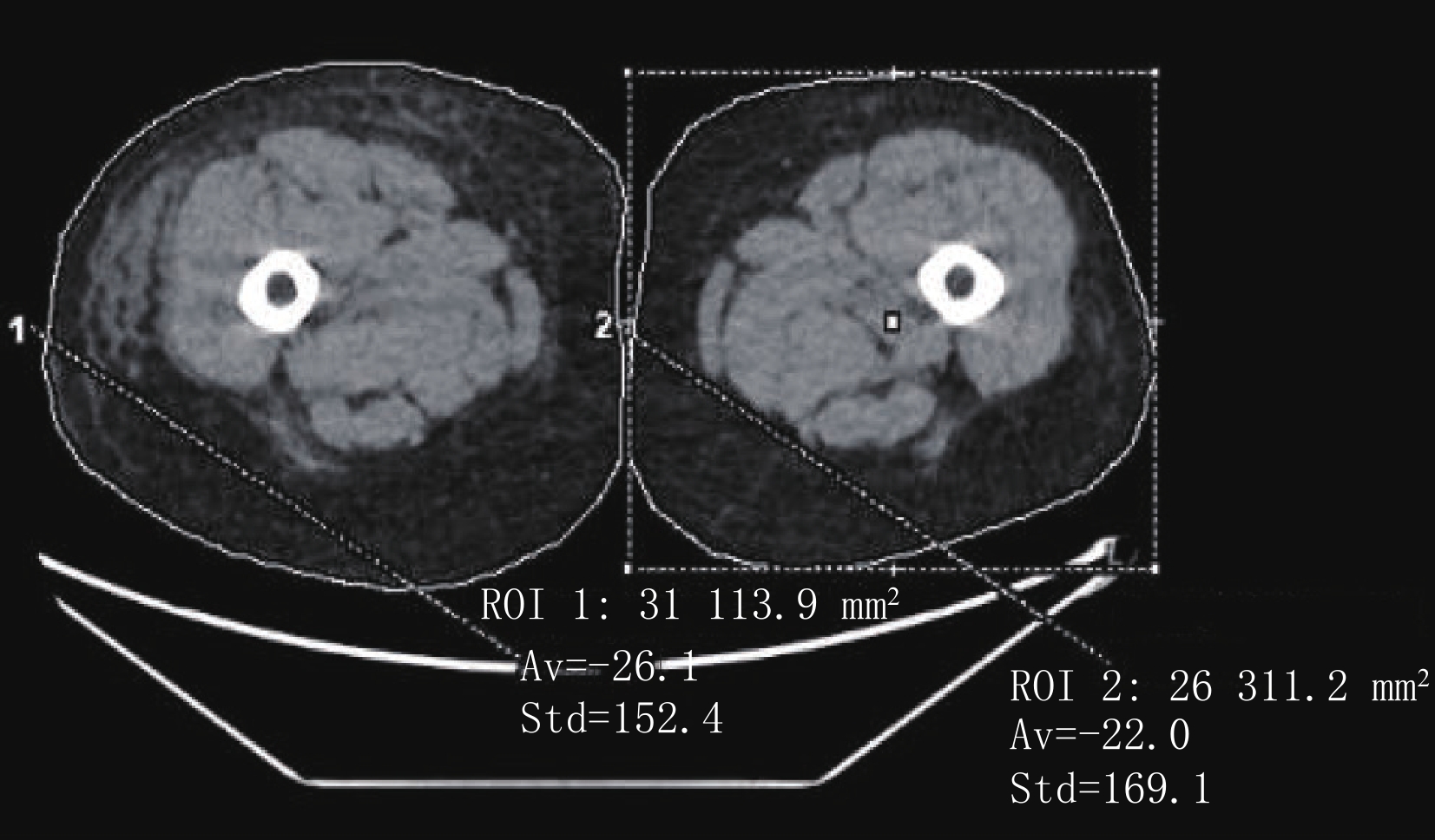
 下载:
下载:
